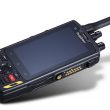Using attenuators to determine fade margin
It is always useful to know just how much fade margin, or “head room,” we have to spare in our communication system. The procedure for determining the head room can be applied to radio-receiving, as well as to remote-control lines. This involves the use of RF attenuators and audio attenuators. High-quality RF attenuators for use at VHF and higher frequencies are difficult to build. Commercially built attenuators that will operate well into the gigahertz range are available at reasonable cost.
On the other hand, attenuators for audio frequency work (pads) are not so critical, and thus they are easily built from ordinary resistors. Precision resistors are recommended because an accumulation of tolerances can reduce the accuracy of the attenuation of the pad. For the type of use described in this column, a resistor tolerance of 1% or 2% should do well.
Radio reception Radio systems are usually designed to provide a signal level well above the 12dB sinad sensitivity level of the receiver. Otherwise, the background noise would be annoying, and there would be no built-in fade margin or head room. In spite of some claims to the contrary, atmospheric weather conditions and other environmental conditions can and do affect signal propagation, even at VHF highband frequencies. Signals at specific locations do not remain at a constant, unwavering level. The level varies under various conditions and at various times of day.
Just how much fade margin does your system have at a particular location? You don’t have to guess. The following test procedure can tell you exactly how much fade margin you have. Of course, the measurement is only valid for the particular time and place of the measurement. Obviously, the greater the fade margin, the more reliable the system will be under adverse propagation conditions. If you make a measurement when the propagation conditions are excellent and find that your fade margin is only a few decibels, then you may have a complete loss of signal under poor conditions.
If you make such a measurement when the propagation conditions are at the lower extreme, and you still have a fade margin of several decibels, then your communications system is apparently up to the task. It is difficult (if not impossible) to design a communications system that produces a strong signal in all parts of the desired coverage area at all times. A communications system designed to achieve this goal (or as near as possible) would probably be cost-prohibitive for most of our customers. A more reasonable and pragmatic approach is usually taken, and systems are designed for a lower percentage of reliability.
Critical communications systems are often designed for 99% reliability or better. This just means that the built-in fade margin is greater than for a system designed for 90% to 95% reliability. Changing a communications system design from 90% to 95% reliability requires considerably more expense, and moving from 95% to 99% drastically increases the expense. Critical links are designed for line-of-sight communications with a fairly high built-in fade margin.
The setup shown in Figure 1, below left, is used to measure fade margin. The attenuator can be the pushbutton or switch type, or it can be a programmable type. (See Photos 1 and 2 above, and Figures 2, 3 and 4 on page 97.) Before running the test, make sure that you are using a mobile radio of the type generally used in the communication system and that the receiver meets the sensitivity specification of the manufacturer. Also, make sure that the tone (1kHz) used to modulate the base station transmitter matches the notch of the sinad meter. Otherwise, the measurement will not be valid.
Go to the location to be checked, and with the base station transmitting a constant 1kHz tone at about 90% system deviation, start with no attenuation switched in. (Disable the tone, or digital squelch code, on the transmitter first to prevent irritating other users of the system). The sinad meter should indicate a good sinad reading (better than the minimum you require). Increase the attenuation until the sinad meter indicates the desired minimum sinad reading. The amount of attenuation switched in is equal to the fade margin of the system at that particular location. You may want to make several measurements within that particular area and average the results. This may provide a more realistic picture than a single measurement at one location.
Telephone line margin Attenuators can be used in a similar manner to check the safety margin on a remote-control line provided by the telco. Excessive line loss can cause problems such as intermittent keying of the transmitter (or other intermittent control functions) and low transmit-receive audio. Audio attenuators can be constructed with various amounts of attenuation for such testing. Balanced pads should be used on balanced telco lines. A balanced “H” pad is shown in Figure 5 at the right. The “H” pad consists of four-arm resistors (RA) and one-leg resistor (RL). The four-arm resistors are of equal value for a simple attenuator pad where the input and output impedance are equal.
Table 1 below shows the value of arm and leg resistors for various amounts of attenuation for a typical 600V line. Look for a safety margin of about 6dB. To check, insert a 10dB attenuator pad and have the console operator at the other end of the line key the transmitter. If the transmitter keys reliably, then you have plenty of safety margin (at least at the keying-tone frequency). If not, reduce the attenuation until the transmitter does key reliably. The maximum amount of attenuation that will still allow the transmitter to key reliably is equal to the safety margin of the system. Don’t just check the transmitter keying. Check all the functions to see that they operate properly. There can be “holes” at certain frequencies on the control line, which may render certain functions inoperative, with less safety margin.
One final note A reader, Rick Harris of Union Pacific Railroad, Salt Lake City, made the following observation about a test setup in the January issue of MRT. The test setup involved Figures 2, 3 and 4 in which a disconnected port on the duplexer was left unterminated during part of the test procedure. Harris asked “Shouldn’t the unused port be terminated with a 50V termination?” Well, “technically speaking,” unused ports should be terminated with the proper system impedance rather than left open. This is considered good standard practice. However, in this case, it probably would have had little effect on the test results because the frequency in use for that part of the test was far removed from the cavity’s resonant frequency.
At the next opportunity I will try it both ways to know for sure. However, Harris’ point is well taken-_if in doubt, terminate!
Until next time_stay tuned!












